
Test Drive III: The Passion
Written by: Rik
Date posted: September 21, 2013
- Genre: Racing
- Developed by: Accolade
- Published by: Accolade
- Year released: 1990
- Our score: 2
When I was a young kid, driving a car seemed like the most exciting thing in the world. Not racing, just driving – on ordinary roads, or on a motorway perhaps. Computer games, of course, offered an opportunity to pretend, and the more a game was like driving a real car on actual roads, the better. For whatever reason, the mundane details of the standard automobile – dashboard, horn, headlights, and, in particular, windscreen wipers – were more exciting to me than the opportunity to drive an F1 car or pull off some crazy stunts.
As an adult, you quickly realise that driving is really boring, and in time I came to understand why my father never seemed as excited as I was about a long motorway trip. No matter how much Richard ‘The Hamster’ Hammond might make sexually suggestive noises while pratting around on an airfield and comparing the car he’s driving to a spicy curry or an unruly wild animal, this is not the lot of the typical motorist, which largely involves cursing van drivers at mini-roundabouts, or sitting in a queue of traffic on the M6.
It was in the context of my previously disproportionate fascination with recreating the real-life driving experience that led me to have soft spot for the Test Drive games. And, yes, that includes this third one, too, despite having previously described it as “rubbish” and “frankly-terrible” elsewhere on the site. While those words seemed entirely suitable based on my last, brief, experiences of the game, they were nevertheless tossed out in a brash and dismissive manner that I now find a little troubling. So, I thought I’d give Test Drive III another, more substantial, go.
By this point it’s probably pretty obvious how things turned out. But be reminded that our policy (with one or two exceptions) is not to be motivated by sinister intentions to review something terrible – it seems a bit pointless just to bash something when you’ve put the effort in, and it’s you’re own time you’re wasting, after all.
And I did once covet and enjoy this game. In many ways it’s a rather progressive title, attempting many things that weren’t tackled again for a number of years. It promises the open road, multiple routes, short-cuts, traffic, weather effects and – crucially – user-operated windscreen wipers, and it delivers all of those things. They are all genuinely in the game, and they do all work as you’d expect. You do have the feeling of having a whole area to play with, rather than just a narrow corridor of tarmac. Alternative routes aren’t signposted in a linear ‘choose this lane or that lane’ manner, you just spot a road and take it – or leave the road entirely and explore the game area that way.
There’s scenery, landmarks, and civilian traffic. The weather changes as you drive. Is it raining? Better turn on the wipers. (At the risk of sounding like some kind of bizarre windscreen-wiper fetishist, you occasionally need to use them to wipe a pixellated dead insect from your screen, too, which is a little touch I really like.) If you drive into water, you don’t crash, the sequence is amended to indicate that you’ve been submerged. Occasionally you’ll be stopped at a level crossing while a train comes through. There are really quite a lot of nice ideas at work here.
Unfortunately it’s all undermined by some fairly fundamental shortcomings. Your enjoyment of the open road is hindered by lots of rather twisty, turny, hilly bits, and a strange driving model that is twitchy and overly responsive. Approach a corner too fast, and you won’t skid or go straight on, the car will just obey your command and turn on a sixpence, sending you hurtling towards the nearest adjacent field or river. Corners can be mastered, but it involves rather too much frenetic wrestling with the keyboard for my liking.
The graphics, too, are pretty awful. There’s a difference between visuals that have simply dated and those that make you think, “Jesus, I don’t actually know what’s happening here”. Negotiating a swervy incline (ironically a hallmark of the original game) becomes slightly disorienting as the scenery, the hill and the road blend into one another and reduce your visibility to zero. It sort of looks okay in stills, but in motion it’s kind of jerky and gets very messy at times. The sound is also a bit crap, with whiny, beepy and squelchy effects, although it doesn’t hinder the overall experience all that much, and while the music is acceptable enough, it really does start to get on your nerves when driving (at one point I feared I wasn’t going to be able to turn it off, as pressing ‘R’ to operate the radio merely switched between different tunes, but thankfully the internet came to the rescue – CTRL-Q is the combination you need).
The format of the racing closely mirrors that of the previous TD game, The Duel. You race along a route (Pacific-Yosemite is the only one provided, although you get another one with the Road & Car data disk – see the extra article for more), which is separated into stages, and can opt to race against opponents or the clock. The main challenge involves successfully negotiating a stage without using up all your lives – once again, pretty much every collision is fatal – which are replenished to some extent at the end of each one. You have a choice of three supercars, two of which are concept prototypes, and the other is the early-90s favourite, the Lamborghini Diablo. They aren’t especially different to drive, although I initially favoured the slowest of the three (the Mythos Pininfarina) purely because a lower top speed made things a bit easier to control.
As with Test Drive 2, it’s all rather short-lived on the easier skill levels, and you could be done in around 40 minutes or so once you know what you’re doing. On harder settings things are complicated by increased levels of traffic, and, more significantly, forcing you to use manual gears, which adds a further level of fiddliness that you could well do without. I did whack it onto the hardest setting to see what it was like, and my gearbox seemed to seize up for no apparent reason, which might indicate that there are some further subtleties (of which I remain ignorant) required for success at the higher levels.
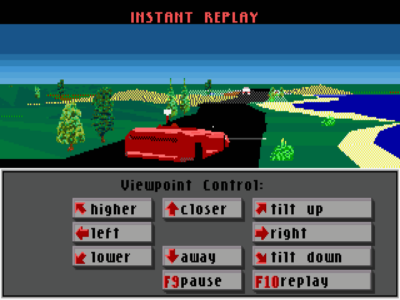
The replay feature allows you to relive some of the game’s baffling occurrences from a different angle.
The police element ostensibly remains the same as before – you have a scanner indicating when you’re likely to encounter the cops, and you need to revise your speed accordingly or prepare to be chased – but somehow the chases are lacking the tension of the previous game or something like The Need for Speed. You rarely feel threatened by the sirens in the background, and it’s pretty easy to stay ahead, which probably explains why the game allows them to stop you just by getting close to you. You don’t even cede control as a ‘slowing down’ sequence or cut-scene plays out – the game simply pauses, whatever speed you’re going, and a text message tells you you’ve been given a time penalty. Other than that, they’re only a minor irritant – you’re more likely to crash into them than anything else.
The best thing you can say about Test Drive III is that it displayed impressive ambition for its time. It’s amazing what they tried to achieve here, and there are some nice little touches to admire. Unfortunately, it has little else to recommend it: the execution is pretty poor, it’s ugly to look at, and it doesn’t play very well. The game suffers in comparison to other similar titles of the era – something like Car & Driver is a better attempt at laid-back driving on real highways, and technologically it’s miles behind one-time Test Drive developers Distinctive Software’s 4D Sports: Driving, released in the same year. Worst of all, it doesn’t even do the car cop-chase thing as well as the previous game in the series, which stands up a whole lot better than this one.

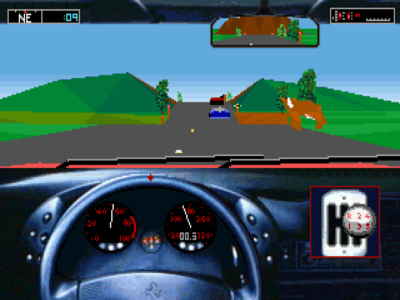
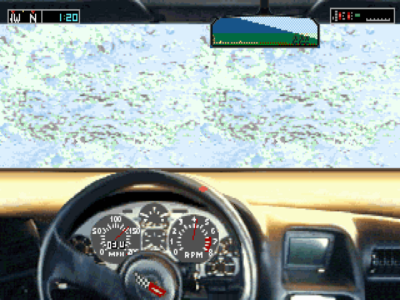
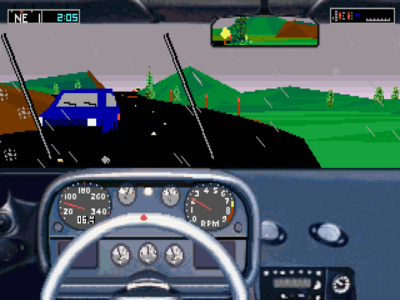
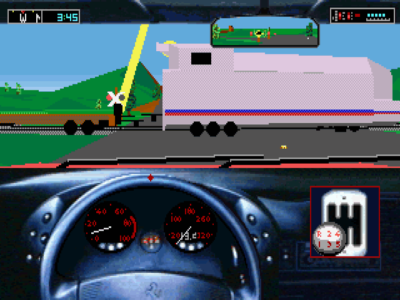

 Posts
Posts
Great game in the best moment (in my opinion) for the PC computers; when video cards and sound cards began to emerge. I loved Test Drive and Test Drive 2 when I saw them on an Amiga 500, and right in the moment that I went from an 8-bit computer to a PC, I saw this game with those stunning 3D polygonal graphics (yes, those things could be possible back then without any modern 3D graphics dedicated card!!!) and I couldn’t believe my new PC was able to play it so smoothly. Great games and great memories of those great beginning of the 90s :'( And I’m with you: these kind of driving simulators where you only had to enjoy a driving experience on actual roads, were much much better than driving an F1 or playing a car race.
April 14, 2018 @ 3:54 pm
I love Test Drive III – I don’t know how much time of my life I had spent in this great 3D environment. 🙂
February 3, 2022 @ 10:40 pm